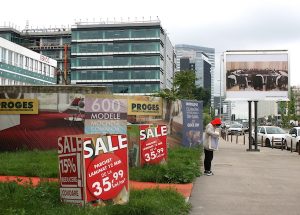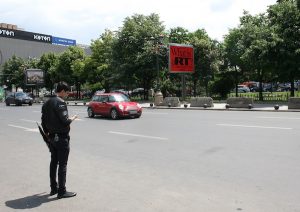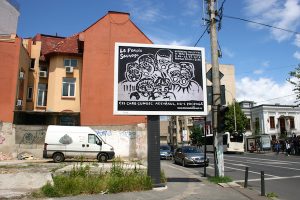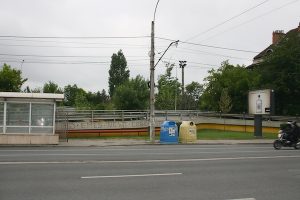Interview by Laura Herman
In a valiant effort to reimagine what a biennale can be, the seventh edition of Bucharest’s Biennale for Contemporary Art What are we building down there? comes with a concept that is both simple and smart. Rather than housing art in various galleries and venues, Belgian curator and critic Niels Van Tomme reshapes our expectations by integrating advertising billboards in the capital city’s infrastructure. Featuring work by twenty artists and collectives, the billboards are both a nod to the increasing privatization of urban space as well as a prime example of how we can navigate the city’s built environment and its social realities differently. But what, as the biennale’s title suggestively asks, are notions of building that could potentially recover a sense of publicness that has nearly become extinct? A conversation with Van Tomme brings answers that are thoughtful and expansive.
The title of the Bucharest Biennale 7 What are we building down there? adopts the form of an open question rather than a proposition. It sets forth the importance of engagement – an open-ended and collective sort of inquiry. How does this implicit mode of address inform the biennale’s conceptual framework?
– It does so by choosing a title that sounds equally popular (like a line from a pop song), engaging, and vaguely geopolitically insensitive. It is indeed, as you rightly point out, very much an open-ended and collective kind of inquiry, but it does so by adding an element that doesn’t feel comfortable: the deliberate use of ‘down there’. Some have said it adds an element of dismissiveness to the title, while others have read it as stating some kind of out-of-place solidarity. Both readings are problematic, of course. But by using it despite these objections I wanted to point out and address the unique position of the Bucharest Biennale within the larger framework of international biennial events, as well as to complicate and problematize notions of marginality and isolation historically assigned to Romania and Eastern Europe more broadly. It is, in other words, very much a rhetorical device, and in that sense it also aligns with the biennial’s other remarkable proposition, namely to view Bucharest as a model city for privatization processes worldwide.
In the past decades Bucharest has gone through several stages of architectural demolition, reconstruction and conversion. Bucharest’s skyline is blighted by endless rows of standardized tower blocks, while its centre is marked by Ceaușescu’s megalomaniac constructions that, in many ways, have become the signifiers of Romania’s traumatic exit from socialism. Over the past years, the city has gone through rapid changes with private investments in office buildings, shopping centre and high-rise apartment blocks. What is the role of building processes in this 7th edition of the BB?
– It is key. But not in the way it is usually understood. At first I was—like everyone who encounters the city for the first time—really struck by the remarkable way in which Bucharest has been shaped by a number of successive architectural ideologies. Most resolutely, state socialism forcefully transformed the city’s former eclectic urban development, which was equally formed by imperial influences from West and East, into a network of state-supervised public and private spaces. A lot of neighbourhoods were being demolished and built. Most remarkably, viable spaces for civic engagement were being eliminated. But that’s history, a history that nevertheless still has an eerie presence.
More visibly, perhaps, I noticed the fierce realization of a contemporary, post-socialist urban reality that resolutely rejects this omnipresent state-socialist heritage. I’m talking here about the architecture of privatized pragmatism that embraces an aggressive, wild capitalist urge for building that doesn’t really have time to consider history or time for deeper reflection. New, hybrid forms of urbanism emerge in which the traditional distinction between ‘private’ and ‘public’ evaporates, which is of course a potentially fertile ground for new things to emerge.
I’m definitely not an architecture expert or urbanist of any kind. I just started to notice things with the fresh look of a privileged outsider, namely a foreign curator who was being asked to curate a biennial in Bucharest. So rather than overemphasize and focus on these multifaceted processes of construction, I was interested in exploring a building of a different kind. As such, the artists as well as the curators in this biennial could be seen as a kind of alternative entrepreneurs, concerned with a different mode of construction. They are laying out and proposing actions for those who currently inhabit the city, making this endeavour at once specific to Bucharest but also applicable to other urban contexts that experience similar processes of privatization.

I’d like to ask you about the role of faction (the mixing of fact and fiction) in this biennale. Although you employ fairy-tale tropes, there is a partial truth in the proposed narrative for the city of Bucharest to be ‘a model for privatization processes worldwide’…
– As mentioned, the proposition to view Bucharest as a model city for privatization processes worldwide really functions more like a rhetorical device which wants to undo historically assigned roles to the region. Truth, of course, is a very relative given, and fairy tales are no less realistic narratives than any other out there. For Metahaven, for example, one of the participants in the biennial, propaganda nowadays is less about propagating an ideology than about undercutting and questioning an existing story. Their contribution to BB7 suggests that our current information overload is the new fuel for propaganda and that the time has perhaps come to move beyond reality itself. This is a powerful proposition, which importantly destabilizes the binary between fact and fiction, and of which the outcome remains wholly unknown.

Let’s talk about the format of the billboard, which over time has become reminiscent of the aesthetic of an early American culture of desire and capitalism more generally. Why have you decided to integrate the billboard in the very particular post-socialist context of Bucharest?
– The billboard is truly all-pervasive in post-socialist Bucharest. We didn’t add it to the equation; it was already flourishing out there, its multifaceted, smooth 2D-surfaces waiting for us to be occupied. At a specific point in the production of BB7—the head sponsor had pulled out; organizationally things were very complex— it seemed the best possible solution. It was partly a pragmatic and economically motivated decision, but of course this inscription in the most vulgarly capitalist and tempting commercial surfaces quite literally translates the themes of privatization, commercialization and corporatization of the post-socialist city within the very structure of the biennial. It thus makes the themes of the BB7 visible in the most transparent way, almost casually yet not without a sense of poetic defiance.
Dispersed across the city, the billboards hold the potential to interact with unique local contexts in ways that traditional modes of exhibition-making oftentimes cannot, yet the question also remains as to how many people will actually see or notice them. Whatever the outcome, BB7 is definitely not another iteration of the global white cube! I very much see the billboards acting as artistic footnotes to the already existing city infrastructure, opening up new ways of interrelating and navigating the city as you travel from one to the other, while making apparent important yet hidden aspects of Bucharest’s multifocal historical layering—its past, present and future.
Despite its strong adherence to—as you describe it—an Americanized culture of desire and capitalism, I’m also interested in how the use of billboards revives an almost anachronistic mode of artistic intervention in physical space, right at the magnified source of our spam-infused everyday existence. There is a very rich and potent history—which is even more pertinent in an Eastern European context—of the historical avant-garde with regards to the liberating and educational potential of advertising as an artistic medium, a theme the Hungarian artist Tamás Kaszás connects with in his contribution to the biennial. And there are of course other important reference points, such as the more deviant culture-jamming practices of the Billboard Liberation Front or a collective like Adbusters. But most of all, I was interested in applying what Keller Easterling so aptly describes as ‘modes of non-oppositional dissent’ and in imagining new ways in which the billboard can be used in parasitic yet resourceful ways. While these former US activist groups tried to hack the billboard format and attack capitalism, we do not oppose any of these. The BB7, as a corporately sponsored biennial, infiltrates the inner workings of capitalism to suggest new modes of resistance. And so the billboards stand as somewhat disturbing yet appealing markers, as they brush against the format’s usual manipulative use.

The BB7 is staged across three main settings–Public Space, Office Space, Domestic Space. Could you address the relationship between those spaces and the role of the subjects who inhabit them?
– To be entirely correct, BB7 used to be staged across those three main settings, at a time when the biennial was still conceived as a more or less traditional exhibition format. At the moment these settings function more like reminiscent spatial metaphors and are no longer linked so directly to the core of the exhibition. I was looking for three spaces that have become ever-more hybrid and are in a sense becoming increasingly interchangeable in a contemporary city fuelled by the incessant piling on of newness, precarious labour conditions, relentless growth, and eager business dynamics. These are also spaces in which a new type of collectivism without communism could emerge, to suggest a somewhat provocative term. Negotiating strategies of movement, translation, trickery and distraction that are scripted by the subjects that inhabit them, the BB7 suggests new ways to navigate urban life.
Could you comment on the selection of twenty artists you commissioned to create an advertisement billboard to temporarily become part of Bucharest’s urban infrastructure? It strikes me that only two are Romanian.
– For one, the Bucharest Biennale has traditionally included international rather than local artists. Without this being a primary reason to continue to do so, there is something to be said for maintaining some sense of continuity from one edition to the next. Furthermore, the politics of negotiating the local art scene as an ‘outsider’ was something I was interestingly confronted with throughout the curatorial process. I feel that the current list of artists adequately represents a dialogue between local concerns and the global themes that its curatorial framework wanted to highlight. I totally understand your concern regarding the participation of Romanian artists, but as my assistant curator Charlotte Van Buylaere rightly points out, the current Berlin Biennale, for example, has a similar percentage of German artists participating. It of course doesn’t justify this sensitive issue, but it does put everything in perspective when trying to grapple with the inner workings of the global biennial machinery. Questioning who else could have been included is of course a natural game to play, but it also becomes meaningless without taking into account the specific context and challenges of this and any biennial.
A small but important specification relates to the fact that the specific timeline of the BB7 included me selecting the majority of the artists long before the idea of the billboards materialized. I fully realize that the question of the billboards somewhat stretches the limits of what is professionally and conceptually acceptable for a curator, but most of the artists understand the exceptional relevance of this economically and infrastructurally necessary measure.
How have the artists responded to your curatorial brief and what were the challenges of working together?
– The challenges were not really related to working together as a team or to thematic concerns or to artistic and political alignments. I conducted studio visits with almost all the artists, or if that was not possible I had extensive conversations with them, so we knew in advance the challenges associated with the BB7. The issues had to do with the precarious working conditions and oftentimes unresolved financial questions. Total transparency in these matters was very important from the beginning. The Danish collective Lehman Brothers, for example, used the impossibility of the BB7 to accommodate the realization of their initially proposed project as an opportunity to advertise something that never happened. And the Romanian artist duo Bors & Ritiu turned their contribution into a critical comment on the privatization of personal thought through religion from a very specific Romanian perspective, as it relates to relentless construction projects by the Church within the capital.
I have to say, though, that a remarkable and for me successful outcome of these unusual conditions and the format they inspired is the fact that some of the artists were pushed out of their comfort zones and started to break with their thematic, aesthetic or political preoccupations. It created, in some cases, a type of movement away from a strange kind of conservatism that sometimes can occur even in the most progressive artistic practices.
So in a way it was amazing how positively the artists responded to our shifting the biennial from ordinary venues to one staged exclusively on billboards, but I also believe that it is in a large part our transparency as a curatorial team that helped foster their enthusiasm. We of course regret that most of the participants could not be paid because the biennial worked with almost no budget. Nevertheless, in collaboration with some of the artists, we succeeded in getting funds from a variety of countries, ranging from state-funded sources in Denmark, Estonia, Japan and Netherlands, to private foundations such as Kadist Art Foundation in San Francisco and CEC Artslink in New York. The big, and in our opinion shameful, exception to this trend was the Flemish Minister of Culture’s decision to not support the Flemish artists participating in BB7, a gesture that negatively impacted not just the biennial, but also the image of this region as truly connected to the contemporary international art sphere.

Across the globe, the international art world seems to be suffering from a creeping ‘biennial fatigue’, fostering scepticism towards its often totalizing format. What are your thoughts on what the BB7 can accomplish for the collapsing political and corporate imaginations it seeks to address?
– I have been thinking a lot about the original strengths of ‘biennalism’, not so much its initial iterations like São Paulo or Venice, but the time when biennials emerged as sites of artistic renewal and critical forward-thinking throughout its heyday in the 1990s. In those times, biennials were staged as digressions from the type of artistic practices or exhibition models that you could experience in the other flourishing institutions of contemporary art, namely museums or art fairs. But those initial stakes have been flattened out and these days it is becoming increasingly hard to find such critical resistance in biennial thinking and organizing. There are of course meaningful alternatives, which also served as an inspiration, such as Bart De Baere’s recent 6th Moscow Biennale or the rather unusual Ghetto Biennale in the slums of Haiti, to name just a few. And more often than not this decision to stage different types of biennial formats is a response to the peculiar socio-economic and geopolitical contexts of these events. They often favour a more humble approach, but nevertheless achieve ambitious results, as they are able to mount a critical dialogue about the future and relevance of biennials and whether the most forward-thinking practices nowadays aren’t to be found in the periphery.
To answer the second part of your question, I don’t think it’s the role of a biennial to actively address these issues. It can point to certain peculiarities and suggest different readings of stringent realities, but it cannot and should not solve them or replace them by something else. But I do think it can create a community of interlocutors, as specific aspects or questions that remain hidden in the maelstrom of everyday life suddenly become apparent. They create, when they are successful, the possibility of dialogue, debate and reflection, or the possibility to expand artistic practices, and in this sense I strongly believe in the potential of biennials. It’s too early now to speak about BB7 in those terms, as it remains to be seen how it resonates locally and internationally.
The setup of the BB7 (and its ‘Travel Agency’ at Onomatopee) seeks—at least in part—to critique the turn at the nexus of tourism and the creative industry, otherwise known as the ‘experience economy’. How do you anticipate the effects of the biennale’s non-standard format to be on its future iterations, and on Bucharest’s cultural landscape (and its consumption) more broadly…
– That’s really impossible to predict. The only thing I can hope for is that BB7 will come to represent a point of sincere reflection on the what, how, when and why of mounting a biennial in Bucharest. I truly believe it is a context for which the international exchanges brought by such an event remains pivotal, and this also holds for the other direction. Romania is a strong historical and contemporary marker for some of the most innovative and singular artistic practices out there. I’m thinking now of artists such as Tristan Tzara, Isidore Isou, Dan Perjovschi or Iona Nemes. The legacy of these people is significant, and thus my efforts will hopefully highlight Romania’s importance rather than marginality to contemporary thinking about the relationship between art and society.
I’m also eager to continue to explore the conceptual limits of the BB7 format. In a sense, the project in its current state has become the perfect traveling exhibition, as it was initially conceived for Bucharest, yet its central themes resonate globally. Biennials generally contain a sense of utopianism, optimism, as well as an inherent structural consistency, as new versions are mounted every two years. With BB7, I am interested in exploring what happens when a biennial project insists on not going away and not moving on. In short, I want to know what the Bartleby of exhibition-making would look like! In this context, I envision BB7 to be mounted in other precarious urban contexts globally, places where processes of commercialization, corporatization and privatization are key. In the meantime, the global experience economy will continue to thrive, and BB8, BB9, and BB10 will be mounted. Yet BB7 will inevitably reshape their meaning as it will stubbornly co-exist with them, in cities as diverse as Beijing, Kinshasa, and Detroit.
The oxymoronic phrase “once upon a time, there will be” is at the centre of a widely known Eastern European political joke that humorously describes the seemingly impossible socio-political realms that can be found in the region, and which has been crucial to my curatorial process for the biennial. Perhaps with this project, once upon a time there will be a BB7, again and again.
If you’re interested in this proposal, you can email me at perpetualbb7@gmail.com.
Interview commissioned by

All images by Charlotte Van Buylaere, courtesy of the Bucharest Biennale.


